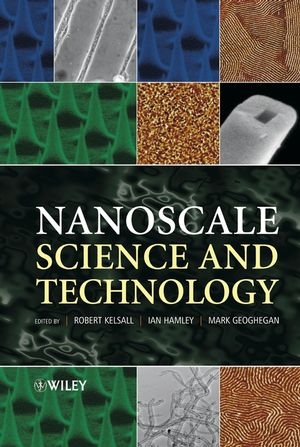
Nanoscale Science and Technology
John Wiley & Sons Inc (Verlag)
978-0-470-85086-2 (ISBN)
Nanotechnology is a vital new area of research and development addressing the control, modification and fabrication of materials, structures and devices with nanometre precision and the synthesis of such structures into systems of micro- and macroscopic dimensions. Future applications of nanoscale science and technology include motors smaller than the diameter of a human hair and single-celled organisms programmed to fabricate materials with nanometer precision.
Miniaturisation has revolutionised the semiconductor industry by making possible inexpensive integrated electronic circuits comprised of devices and wires with sub-micrometer dimensions. These integrated circuits are now ubiquitous, controlling everything from cars to toasters. The next level of miniaturisation, beyond sub-micrometer dimensions into nanoscale dimensions (invisible to the unaided human eye) is a booming area of research and development. This is a very hot area of research with large amounts of venture capital and government funding being invested worldwide, as such Nanoscale Science and Technology has a broad appeal based upon an interdisciplinary approach, covering aspects of physics, chemistry, biology, materials science and electronic engineering. Kelsall et al present a coherent approach to nanoscale sciences, which will be invaluable to graduate level students and researchers and practising engineers and product designers.
Robert W Kelsall is Course director for the joint Leeds/Sheffield MSc in Nanoscale Science and Technology, which was one of the first (and is currently one of the largest) taught postgraduate nanotechnology programmes to be established in Europe. Ian Hamley and Mark Geoghegan are both actively involved in the delivery of the course. All three Editors manage substantial research programmes covering low-dimensional semiconductor devices, structured surfaces and interfaces, polymers and soft matter.
List of contributors. Preface.
Chapter authors.
1 Generic methodologies for nanotechnology: classification and fabrication.
1.1 Introduction and classification.
1.2 Summary of the electronic properties of atoms and solids.
1.3 Effects of the nanometre length scale.
1.4 Fabrication methods.
1.5 Preparation, safety and storage issues.
Bibliography.
2 Generic methodologies for nanotechnology: characterization.
2.1 General classification of characterization methods.
2.2 Microscopy techniques.
2.3 Electron microscopy.
2.4 Field ion microscopy.
2.5 Scanning probe techniques.
2.6 Diffraction techniques.
2.7 Spectroscopy techniques.
2.8 Surface analysis and depth profiling.
2.9 Summary of techniques for property measurement.
Bibliography.
3 Inorganic semiconductor nanostructures.
3.1 Introduction.
3.2 Overview of relevant semiconductor physics.
3.3 Quantum confinement in semiconductor nanostructures.
3.4 The electronic density of states.
3.5 Fabrication techniques.
3.6 Physical processes in semiconductor nanostructures.
3.7 The characterisation of semiconductor nanostructures.
3.8 Applications of semiconductor nanostructures.
3.9 Summary and outlook.
Bibliography.
4 Nanomagnetic materials and devices.
4.1 Magnetism.
4.2 Nanomagnetic materials.
4.3 Magnetoresistance.
4.4 Probing nanomagnetic materials.
4.5 Nanomagnetism in technology.
4.6 The challenges facing nanomagnetism.
Bibliography.
5 Processing and properties of inorganic nanomaterials.
5.1 Introduction.
5.2 The thermodynamics and kinetics of phase transformations.
5.3 Synthesis methods.
5.4 Structure.
5.5 Microstructural stability.
5.6 Powder consolidation.
5.7 Mechanical properties.
5.8 Ferromagnetic properties.
5.9 Catalytic properties.
5.10 Present and potential applications for nanomaterials.
Bibliography.
6 Electronic and electro-optic molecular materials and devices.
6.1 Concepts and materials.
6.2 Applications and devices.
6.3 Carbon nanotubes.
Appendix: Reference table of organic semiconductors.
Bibliography.
7 Self-assembling nanostructured molecular materials and devices.
7.1 Introduction.
7.2 Building blocks.
7.3 Principles of self-assembly.
7.4 Self-assembly methods to prepare and pattern nanoparticles.
7.5 Templated nanostructures.
7.6 Liquid crystal mesophases.
7.7 Summary and outlook.
Bibliography.
8 Macromolecules at interfaces and structured organic films.
8.1 Macromolecules at interfaces.
8.2 The principles of interface science.
8.3 The analysis of wet interfaces.
8.4 Modifying interfaces.
8.5 Making thin organic films.
8.6 Surface effects on phase separation.
8.7 Nanopatterning surfaces by self-assembly.
8.8 Practical nanoscale devices exploiting macromolecules at interfaces.
Bibliography.
9 Bionanotechnology.
9.1 New tools for investigating biological systems.
9.2 Biomimetic nanotechnology.
9.3 Conclusions.
Bibliography.
Index.
| Erscheint lt. Verlag | 25.2.2005 |
|---|---|
| Verlagsort | New York |
| Sprache | englisch |
| Maße | 174 x 253 mm |
| Gewicht | 1021 g |
| Themenwelt | Naturwissenschaften ► Chemie |
| Naturwissenschaften ► Physik / Astronomie ► Thermodynamik | |
| Technik ► Elektrotechnik / Energietechnik | |
| ISBN-10 | 0-470-85086-8 / 0470850868 |
| ISBN-13 | 978-0-470-85086-2 / 9780470850862 |
| Zustand | Neuware |
| Haben Sie eine Frage zum Produkt? |
aus dem Bereich


